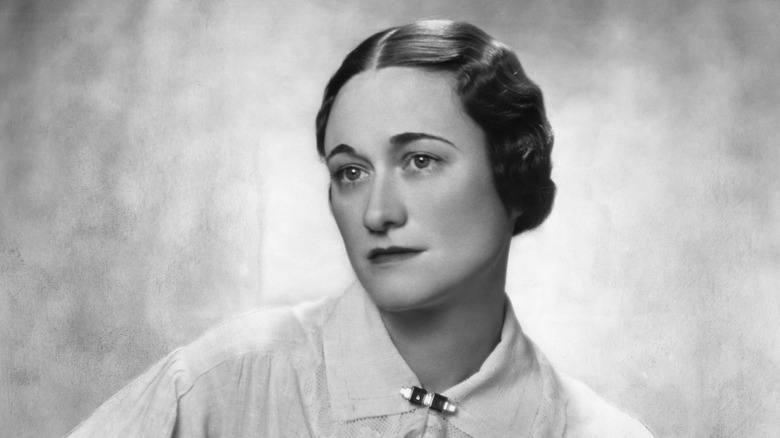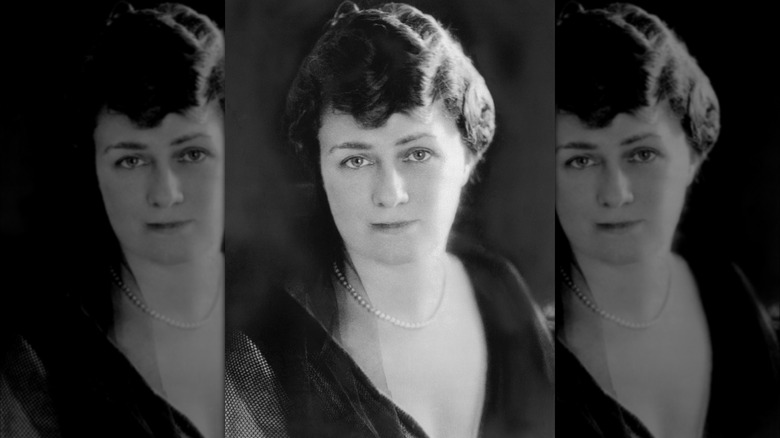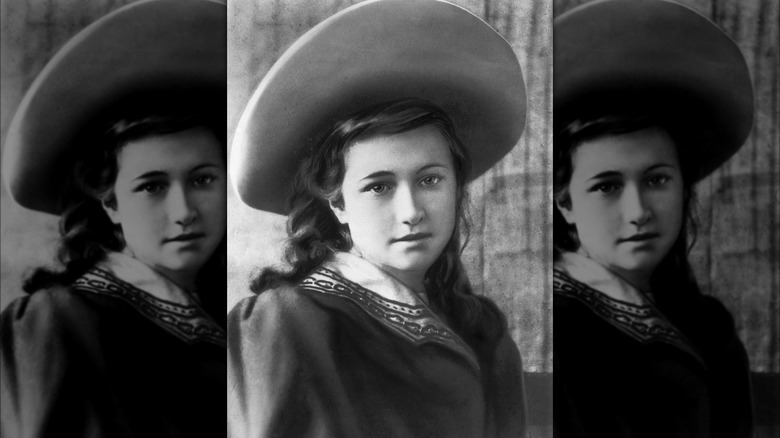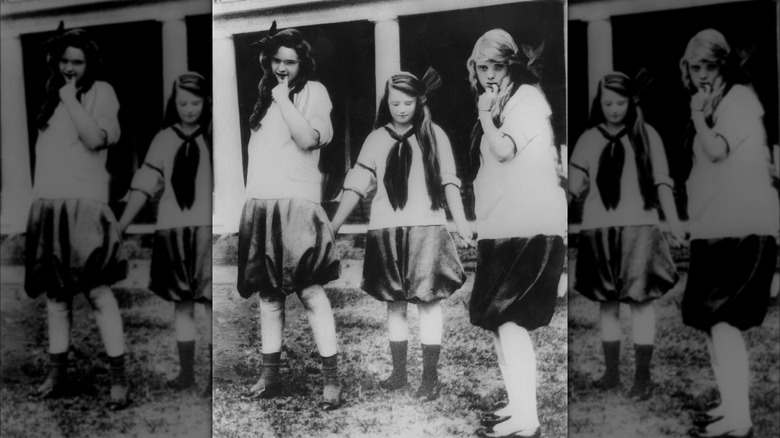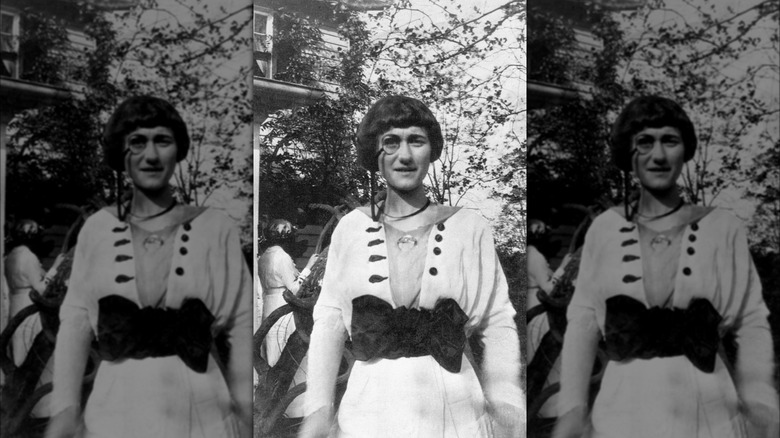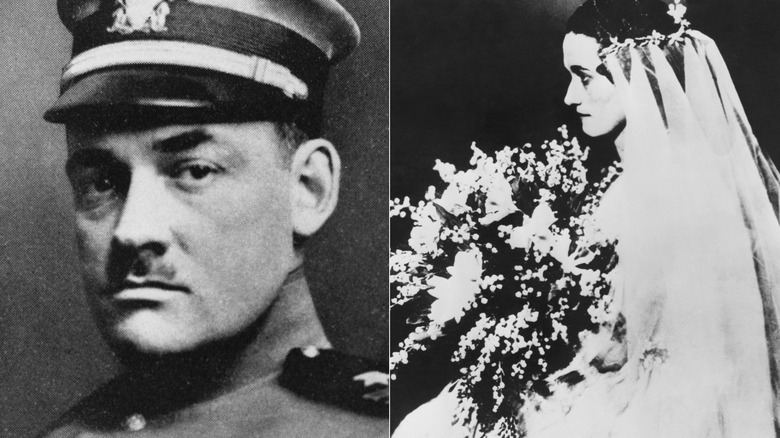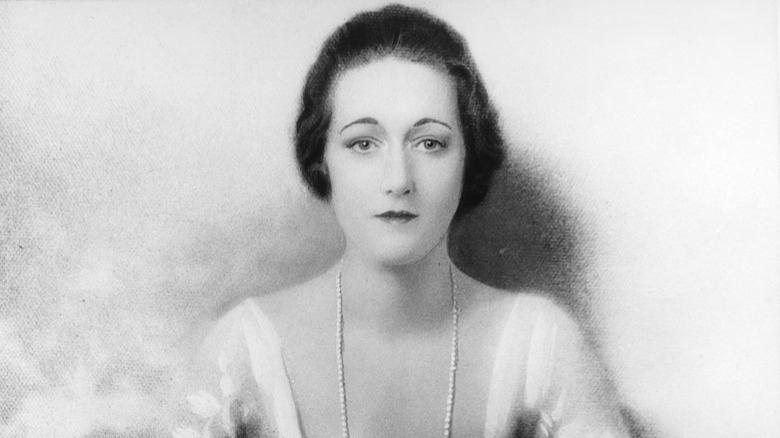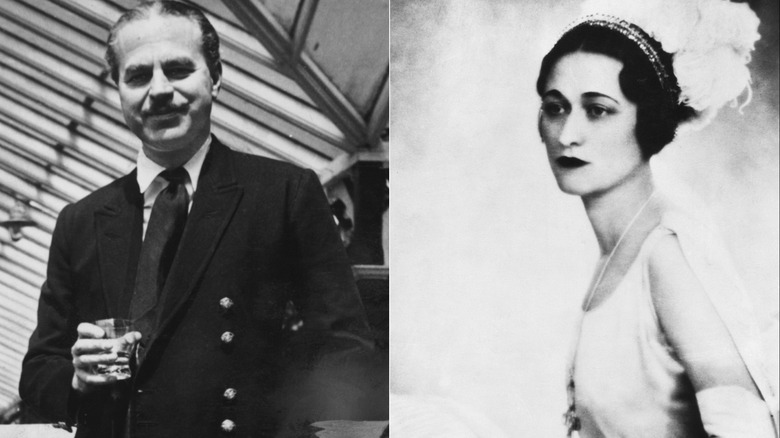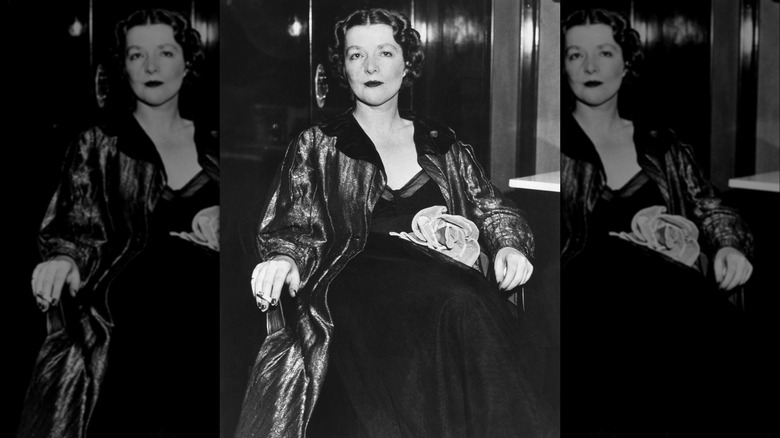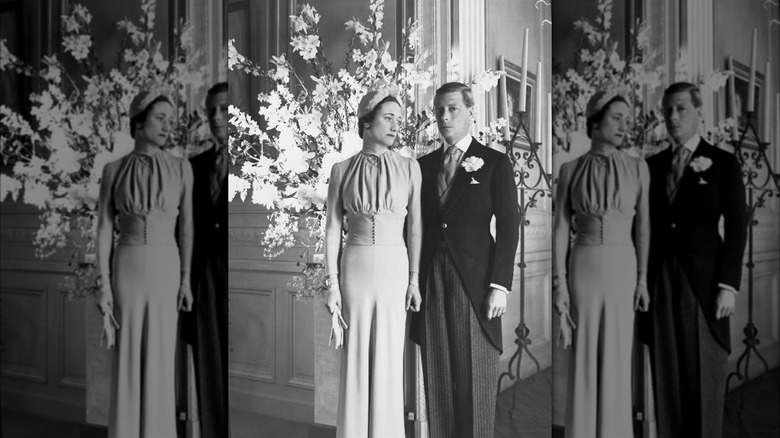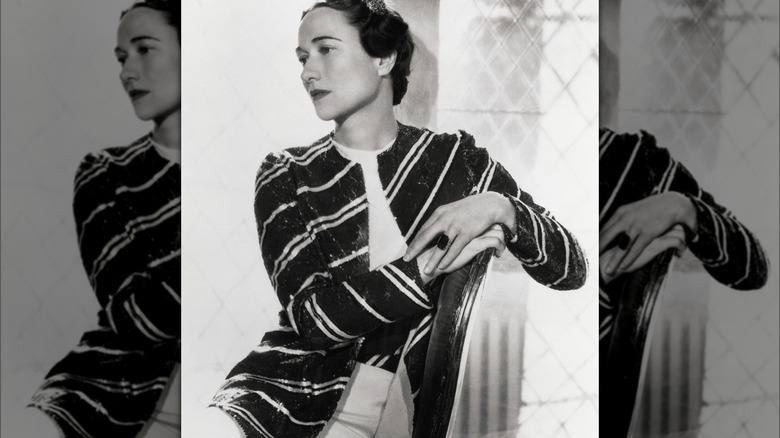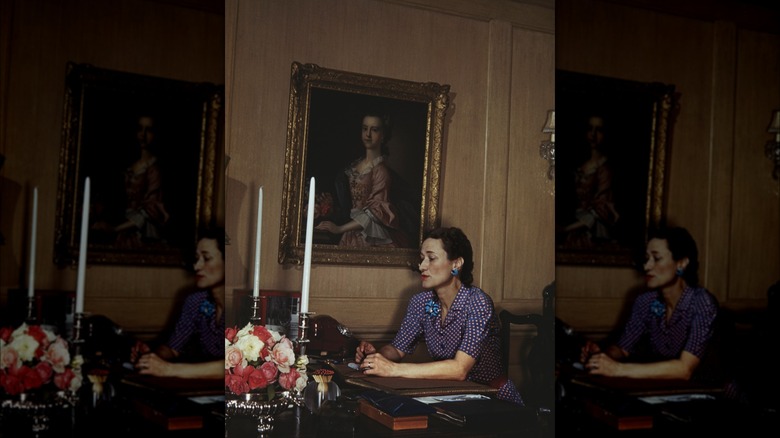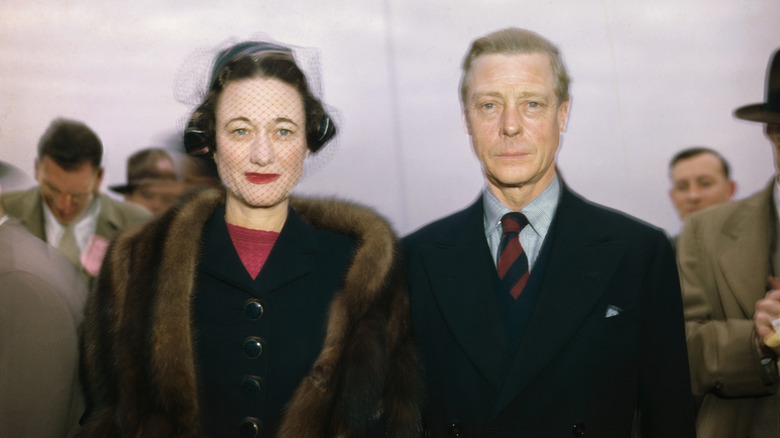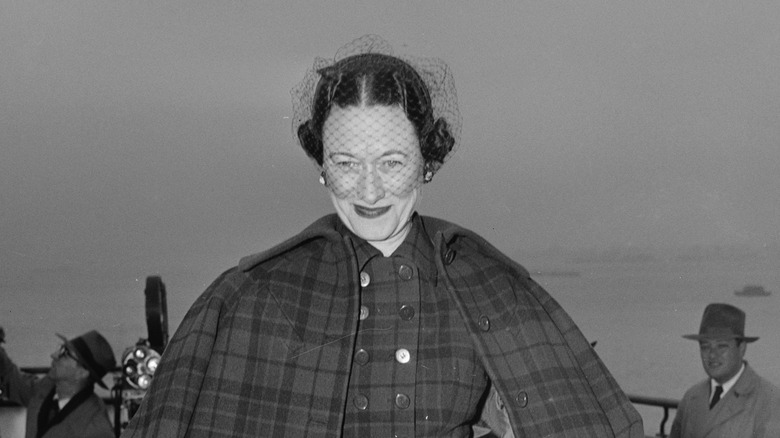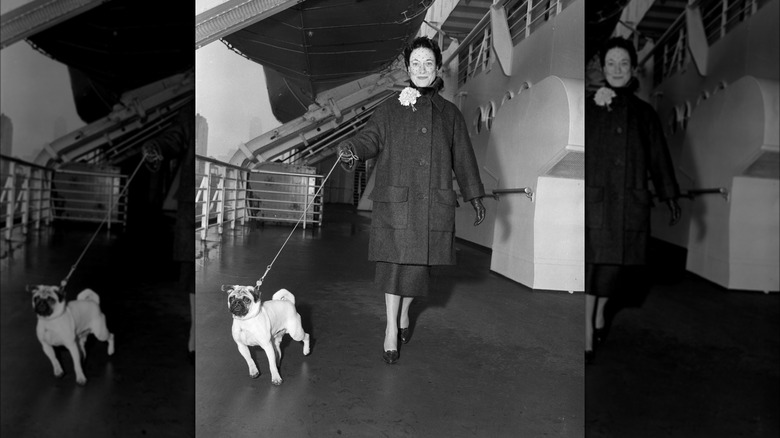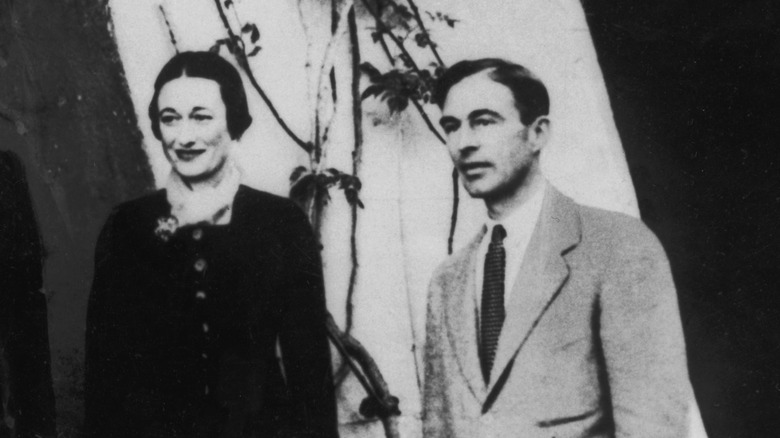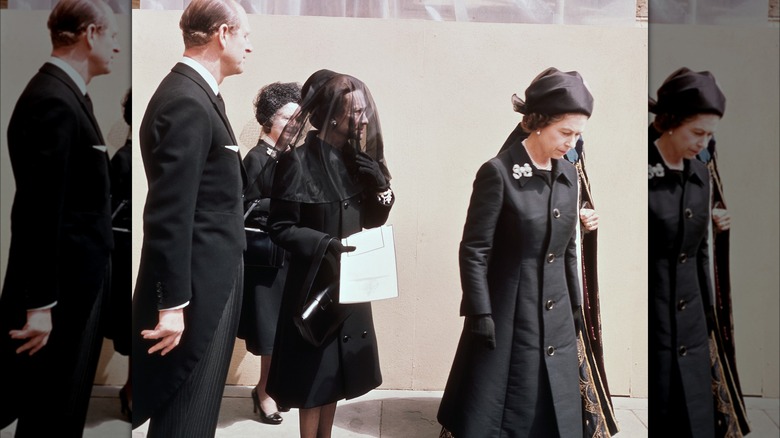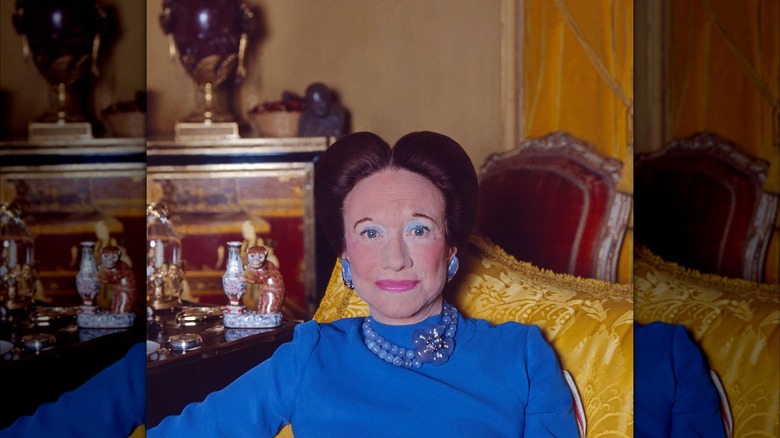Tragic Details About Wallis Simpson's Life
In December 1936, King Edward VIII shocked the world with his abdication announcement. He would leave everything behind for his love: an American divorcée named Wallis Simpson.
Long before Meghan Markle's marriage history shocked the English blue bloods, Simpson was the topic of conversation when she wed the former British monarch. In the 1930s, divorce still very much carried a social stigma, and it would have been considered improper for an English king to wed a woman who had not only been divorced once, but twice.
Six months after Edward stepped down, the two got hitched. Edward and Simpson's marriage has since gone down in history as one of the most drama-filled love stories of the 20th century, but what about Simpson's life outside of their relationship? While marrying a king may sound like something out of a fairytale, the American socialite lived a tragedy-stricken life.
The scandal surrounding her birth
Wallis Simpson's mother and father might've had an illicit love affair of their own. Her parents, Teackle Wallis Warfield and Alice Montague (pictured above), hailed from old money, meaning that adhering to the longstanding customs of marrying before having children would have been paramount.
As Anne Sebba shared in "That Woman: The Life of Wallis Simpson Duchess of Windsor," there have been rumblings about Simpson's parents possibly being unmarried when she was conceived. Bessie Wallis Warfield, as she was named by her parents, was born on June 19, 1896. Simpson would later claim that her parents married in June of 1895. However, the timeline might not be so neat; Sebba dug up an article published in The Baltimore Sun in 1895 that reported Teackle Wallis Warfield wed Alice Montague on November 19 of that year — only seven months before Simpson's birthday.
She never knew her father
Tragedy struck Wallis Simpson's family when her father passed away from tuberculosis when she was only 5 months old. Not only did this mean that Simpson was never given the chance to form a relationship with her father, but it also meant that Alice Montague was not only a new parent, but a single mother. In the patriarchal society of the early 1900s, Simpson's mother did not have the tools to forge a career and financially support herself.
Simpson and Montague leaned on relatives for years. Her late father's brother, wealthy railroad executive Solomon Davies Warfield, welcomed them into his Baltimore home. They stayed with Warfield for a few years, but it wasn't long before they were moving again. They then spent some time living with Montague's aunt before relocating once more. Simpson's childhood was defined by early parental loss and an unsettled domestic life.
Her stepfather died
Matters began looking up when Wallis Simpson's mother remarried in 1908. Alice Montague wed a man named John Freeman Rasin, the son of a wealthy political leader in their home city of Baltimore.
However, little did they know, another tragedy was just around the corner for their family. After only five years of marriage, Rasin died, making Montague a widow yet again. As Anne Sebba noted in "That Life," the emotional toll of living through two husbands' deaths broke Simpson's mother, transforming her into nothing more than a "dark shadow" of her former self.
Rasin's death, then, effectively robbed the young Simpson of two parental figures. While the tween and her mother had once been a tight-knit family unit, their relationship was never the same following Montague's inability to process the grief of her second husband's death. What's more, the mother and daughter were again unmoored.
She was seen as an outcast at school
If you were a child of a distinguished family in the 20th century, it would be expected of your parents to send you to a prestigious boarding school. In fact, recent reports hint that the Prince and Princess of Wales may keep with royal tradition and send their son Prince George to boarding school when the time comes.
Though she was not born into royalty, Wallis Simpson did hail from an upper crust family and was sent to a boarding school in Maryland called Oldfields. Although her family had the pedigree, Simpson evidently struggled to fit in with her classmates. She reportedly had a reputation for smoking, breaking the rules, and flirting with boys. As Anne Sebba wrote in "That Life," "Some of the parents at the time believed that there was something extraordinary about Wallis and that her influence was malign."
Her first marriage was an unhappy one
Despite her rough start in life — from parental deaths to classroom alienation — it didn't take Wallis Simpson long to find love. Or, at least, what she thought was love at the time. On November 8, 1916, the 20-year-old married her first husband, a U.S. naval aviator named Earl Winfield Spencer Jr.
Although the freshly graduated young socialite was ticking all the boxes of what was expected of her from her upper-crust society, things would eventually take a turn for the worst when her marriage began to crumble. As Anne Sebba recounted in "That Woman," Spencer not only struggled with alcohol misuse, but he spent a great deal of time of away from home. This created a lot of tension within his and Simpson's marriage. The two unofficially separated multiple times in the course of their 11-year marriage. Simpson and Spencer finally divorced in 1927.
She lost a fortune in the Wall Street Crash of 1929
Although the late 1920s should have been a roaring time for Wallis Simpson — after all, the young socialite had just broken out of an unhappy marriage with her first husband — her bank account would soon take a tragic hit.
Like many upper-class Americans of the time, Simpson and her mother derived much of their income from wise investments on Wall Street. This all changed in 1929, when the U.S. stock market took a drastic nosedive, with share prices on the New York Stock Exchange eventually crumbling in November of that year. The catastrophic event is now known as The Wall Street Crash of 1929.
What followed was a decade of high unemployment and widespread poverty, otherwise known as The Great Depression. The hit was so hard that when Simpson's mother died on November 2, 1929, she was virtually penniless.
Her second marriage ended in divorce
Whether or not there was truth to Wallis Simpson's "man-eater" reputation, it's clear men were drawn to her. As Anne Sebba recounted in "That Life," she had already struck up a flirtation with Ernest Aldrich Simpson before her first divorce papers were even signed.
It was messy, to say the least. The two first had to be granted divorces from their respective spouses before marrying on July 21, 1928. Then, they moved to England to start a new life. However, the couple's move eventually spelled the demise of this marriage as well.
After meeting and befriending the man who would come to define her legacy — Prince Edward, heir to the British throne — her marriage to Ernest took the backseat. What followed was a love triangle that led to a constitutional crisis for the U.K. and a second divorce on Simpson's record.
She ruined her relationship with one of her oldest friends
In 1936, Wallis Simpson reached out to a woman named Mary Kirk (pictured above), a childhood friend and fellow Oldfields School alum, and invited her to visit Windsor Castle with them. As noted in Air Mail, at the time, Wallis wanted out of her marriage to Ernest Simpson so she could marry King Edward VIII. So, she orchestrated a plan that made Mary look like Ernest's mistress. The plan ultimately worked: Not long after Kirk started spending time with the Simpsons, rumors began circulating about her relationship with Ernest.
Kirk and Ernest did ultimately get together, but Kirk still resented her old friend for using her. "Even though she loathed and despised having me there, it served her purpose as then she could say Ernest was having an affair with me and so she would have to get a divorce," she wrote in her journal.
She was forced to flee England
Wallis Simpson's life changed forever when her lover ascended the throne in January of 1936. While many hypothesize that her goal was to eventually become queen this would never come to pass. On the contrary, Simpson was pushed out of England altogether.
With the monarchy inextricably intertwined with the Church of England, King Edward VIII was refused permission to marry Simpson on the grounds of her divorces. However, he refused to give her up as his mistress. In December of that year, the news of their relationship leaked to the British public.
Caught in a media storm, Simpson fled to France. There, she hid out at a friend's villa for an extended period of time to wait out the drama. Evidently, the media didn't give up easily. As Andrew Morton noted in "Wallis in Love," she once called the press a "ravenous besieging army."
No family members attended her wedding to the Duke of Windsor
On December 10, 1936, King Edward VIII signed the Instrument of Abdication, officially stepping down from the throne, becoming the Duke of Windsor. In a radio broadcast, he declared, "I have found it impossible to carry the heavy burden of responsibility ... without the help and support of the woman I love."
The following months saw a series of abdication laws unrolling across the U.K. Meanwhile, Wallis Simpson remained wrapped up in complex divorce proceedings with her then-husband Aldrich Simpson. Finally, Edward and Simpson were officially married on June 3, 1937, becoming the Duke and Duchess of Windsor.
The controversial royal wedding was a bit of a melancholy affair, as there wasn't a single member of the royal family in attendance. Needless to say, it was far more intimate than, say, Prince William and Princess Catherine's nuptials.
Her post-exile life was aimless
After the lovebirds overcame all the odds, said goodbye to the royal family, and finally said "I do," they were ready for the next chapter of their fairytale. Tragically, the reality of Wallis Simpson and Edward VIII's relationship was far less blissful than any Disney movie would have led you to believe.
In "That Life," biographer Anne Sebba described the Duke and Duchess of Windsor's life in France away from the royal family as being something of an aimless existence. With no real careers or chief charitable causes to champion, the former king and his wife were nothing but bored aristocrats, alienated from their families and former home country.
Eventually, the reality of the situation settled in for both Simpson and the former monarch. As Sebba wrote, "Nothing else in his life gave him any sense of achievement other than his marriage to Wallis."
She was widely disliked in England
After her British royal beau gave up the crown, American socialite Wallis Simpson was not exactly popular in his home country. Tabloids painted her as an opportunist snob, and citizens evidently didn't give her a warm welcome. As Anne Sebba recounted in "That Woman," she was referred to as an "American harlot" in graffiti; Zippy Larson, a Baltimore tour guide, once told Fox affiliate WBFF that people would throw rocks at her car when she drove through town. "The Brits felt she had stolen their king, she captured him and stole him off the throne," Larson said.
The reported harassment didn't end there. As noted by the BBC, some Daily Express reporters were caught throwing bricks through the windows of Simpson's apartment in Regent's Park, London. Even after she relocated to France, Simpson would continue to receive boxes upon boxes of hate mail.
She struggled with loneliness
One of the most tragic aspects of Wallis Simpson's story was not the material matters of her life, such as her exile from England or her financial losses, but rather, the internal wounds she endured at the hands of the British press and public. While she never publicly opened up about the pain she felt, private letters obtained by Channel 4 reveal the toll her reputation took.
In letters to her second ex-husband, Ernest Simpson, the Duchess of Windsor revealed details of her own mental health. She described life as "waking emptiness" and feels her entire existence is "one colossal bore." Noting her lonely state, she went on to write, "I feel small and licked by it all — I can't think of what sort of mess I am leaving for — I am sorry for myself — I am sorry for the King — I hate stuffy British minds."
Her love for Edward VIII began to fizzle
Although the Duke and Duchess of Windsor's love story has been portrayed as an epic tale of two star-crossed lovers, the reality is that Wallis Simpson often felt trapped and unhappy in her marriage to the former king of England. After speaking with contemporaries and old friends of the couple, biographer Anne Sebba claims that Simpson's happily ever after was really a tragedy.
"Few who knew them well described what they shared as love," Sebba told Politico. One of the couple's blue blood friends, Constance Coolidge, even spoke with the Toronto Star in 2018, claiming that the Duchess of Windsor was unhappy behind closed doors and felt resentment toward her husband. Coolidge offered an explanation for her friend's misery, asking, "Can you imagine a more terrible fate than to have to live up publicly to the legend of a love you don't feel?"
In 1949, her jewelry was stolen
Wallis Simpson was a victim of a burglary in 1949. As writer Alexander Larman recounted in the Daily Mail, Simpson and Edward VIII were staying with their friend the Earl of Dudley in Berkshire when the incident occurred.
When the crew of nobles left for a dinner in London, thieves descended upon the estate and turned the home upside-down. In total, the Duchess of Windsor ended up losing £25,000 worth of jewels. When inflation is factored in, this loss amounts to over £1 million today.
After news broke of the burglary, rumors swirled about what really happened. Simpson chose not to lock up her jewelry in the property's vault, a move that helped fuel the theory that the Windsors themselves planned the theft to commit insurance fraud. However, no evidence of these claims were found, and the duchess never retrieved her losses.
The speculation about why she didn't have children
Wallis Simpson was married three times, but she never had children. The Duchess of Windsor never spoke about whether or not she wanted to be a mother, but there have been a number of theories and speculation regarding why she and the duke didn't have kids. While it's entirely possible that they weren't interested in being parents, it is also possible that their childfree life was met with great sadness, as it is by many couples who experience infertility.
One theory is that Simpson suffered complications from an abortion in her youth, leaving her unable to conceive. Others suggest that a case of mumps from the Duke of Windsor's childhood may have rendered him unable to conceive. As noted in the Daily Mail, Simpson did once allude to the reason why they didn't have kids, reportedly stating, "My husband isn't heir-conditioned."
She was apparently in love with someone else
You may not know that Wallis Simpson's one true love allegedly wasn't Edward, Duke of Windsor. According to Andrew Morton, she apparently was head-over-heels for a man named Herman Rogers. As Morton recounted in his book "Wallis in Love," Rogers was a wealthy American who Simpson knew from her Baltimore days. Yet, despite having friends and a moneyed background in common, Rogers reportedly only ever saw Simpson in a platonic light.
When his first wife died from cancer in 1949, Simpson supposedly jumped at the chance to get her long-held crush into bed. According to Morton's account, she's said to have sent a telegram that read, "Don't do anything until I get there. Your guardian angel." However, it wasn't long until Rogers was engaged to another woman. At the wedding, Simpson reportedly told the bride, "He's the only man I've ever loved."
She was widowed in 1972
If living in exile for decades with a husband you don't love doesn't sound tragic enough, try being widowed by that same husband, left to fend for yourself in the cutthroat world of European aristocrats. This is what happened to Wallis Simpson when her third husband, Edward, Duke of Windsor, passed away from throat cancer in 1972.
After having avoided London for years, Simpson finally returned to the city to attend the duke's funeral. In what was certainly a surprising turn of events, Simpson stayed at Buckingham Palace with her late husband's family during her visit. Throughout the funeral processions, Simpson was photographed moving around the city clad in traditional all-black mourning gear, with her head downcast. As The New York Times noted in the duke's obituary, "Then the Duchess of Windsor, in perhaps the most poignant few moments, stood motionless, head bowed, before the coffin."
At the end of her life, she was exploited
Without her husband by her side, the elderly Wallis Simpson lived out the rest of her days as a recluse. She was eventually diagnosed with dementia, with her illness making her vulnerable to exploitation.
It's been reported that Simpson's lawyer, Suzanne Blum, hijacked the duchess's accounts, assuming power of attorney, and even publishing old love letters between the famed couple without Simpson's permission. Often sedated and too frail to physically protest, Simpson was reduced to a prisoner in her own mansion. In "Behind Closed Doors," writer Hugo Vickers called Blum a "Satanic figure ... wearing the mantle of good intentions to disguise her inner malevolence."
Simpson died on April 24, 1986, of bronchial pneumonia. She was 89 years old. As The Guardian noted in an obituary, she did not have any close family members by her side in her final years.
